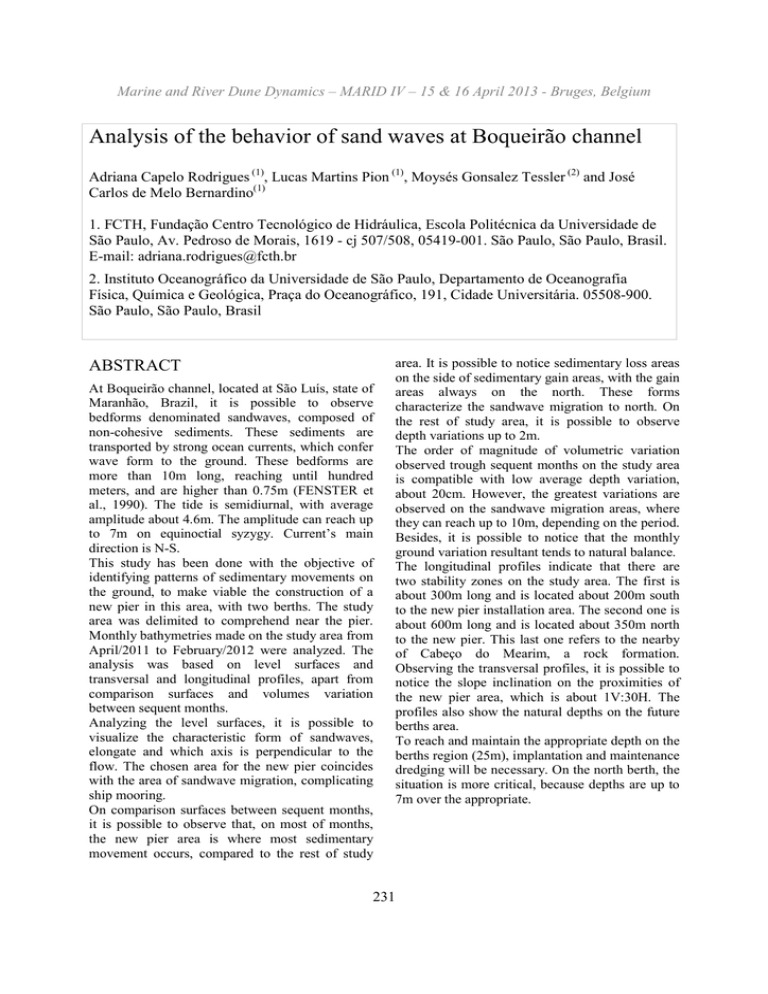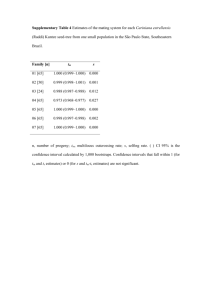Analysis of the behavior of sand waves at Boqueirão channel
advertisement

Marine and River Dune Dynamics – MARID IV – 15 & 16 April 2013 - Bruges, Belgium Analysis of the behavior of sand waves at Boqueirão channel Adriana Capelo Rodrigues (1), Lucas Martins Pion (1), Moysés Gonsalez Tessler (2) and José Carlos de Melo Bernardino(1) 1. FCTH, Fundação Centro Tecnológico de Hidráulica, Escola Politécnica da Universidade de São Paulo, Av. Pedroso de Morais, 1619 - cj 507/508, 05419-001. São Paulo, São Paulo, Brasil. E-mail: adriana.rodrigues@fcth.br 2. Instituto Oceanográfico da Universidade de São Paulo, Departamento de Oceanografia Física, Química e Geológica, Praça do Oceanográfico, 191, Cidade Universitária. 05508-900. São Paulo, São Paulo, Brasil ABSTRACT At Boqueirão channel, located at São Luís, state of Maranhão, Brazil, it is possible to observe bedforms denominated sandwaves, composed of non-cohesive sediments. These sediments are transported by strong ocean currents, which confer wave form to the ground. These bedforms are more than 10m long, reaching until hundred meters, and are higher than 0.75m (FENSTER et al., 1990). The tide is semidiurnal, with average amplitude about 4.6m. The amplitude can reach up to 7m on equinoctial syzygy. Current’s main direction is N-S. This study has been done with the objective of identifying patterns of sedimentary movements on the ground, to make viable the construction of a new pier in this area, with two berths. The study area was delimited to comprehend near the pier. Monthly bathymetries made on the study area from April/2011 to February/2012 were analyzed. The analysis was based on level surfaces and transversal and longitudinal profiles, apart from comparison surfaces and volumes variation between sequent months. Analyzing the level surfaces, it is possible to visualize the characteristic form of sandwaves, elongate and which axis is perpendicular to the flow. The chosen area for the new pier coincides with the area of sandwave migration, complicating ship mooring. On comparison surfaces between sequent months, it is possible to observe that, on most of months, the new pier area is where most sedimentary movement occurs, compared to the rest of study area. It is possible to notice sedimentary loss areas on the side of sedimentary gain areas, with the gain areas always on the north. These forms characterize the sandwave migration to north. On the rest of study area, it is possible to observe depth variations up to 2m. The order of magnitude of volumetric variation observed trough sequent months on the study area is compatible with low average depth variation, about 20cm. However, the greatest variations are observed on the sandwave migration areas, where they can reach up to 10m, depending on the period. Besides, it is possible to notice that the monthly ground variation resultant tends to natural balance. The longitudinal profiles indicate that there are two stability zones on the study area. The first is about 300m long and is located about 200m south to the new pier installation area. The second one is about 600m long and is located about 350m north to the new pier. This last one refers to the nearby of Cabeço do Mearim, a rock formation. Observing the transversal profiles, it is possible to notice the slope inclination on the proximities of the new pier area, which is about 1V:30H. The profiles also show the natural depths on the future berths area. To reach and maintain the appropriate depth on the berths region (25m), implantation and maintenance dredging will be necessary. On the north berth, the situation is more critical, because depths are up to 7m over the appropriate. 231 Marine and River Dune Dynamics – MARID IV – 15 & 16 April 2013 - Bruges, Belgium REFERENCES Fenster, M.S., Fitzgerald, D.M., Bohlen, W.F., Lewis, R.S. and Baldwin, T.: “Stability of giant sand waves in eastern Long Island Sound”, páginas 207-225, vol 91, Marine Geology, U.S.A., 1990. 232

